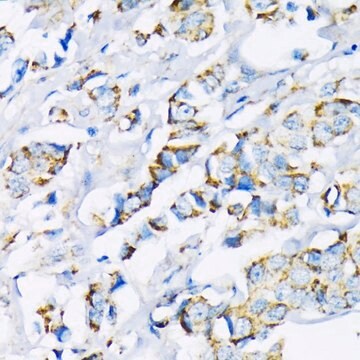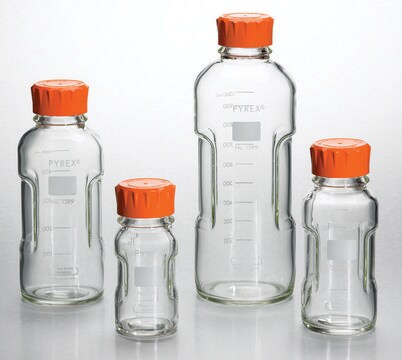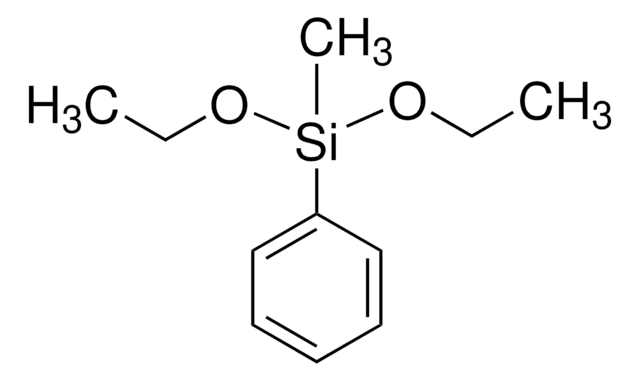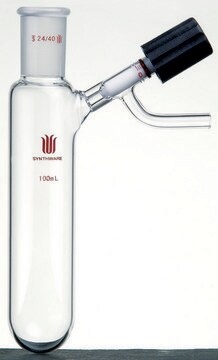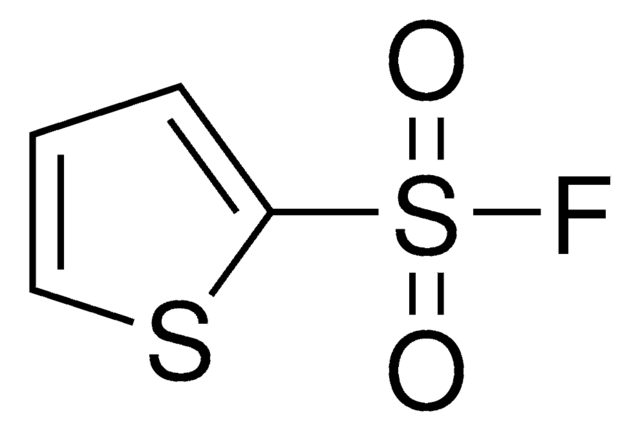AB3279
Anti-Hexokinase Type II Antibody
Chemicon®, from rabbit
Synonym(s):
HK II
Sign Into View Organizational & Contract Pricing
All Photos(1)
About This Item
UNSPSC Code:
12352203
eCl@ss:
32160702
NACRES:
NA.41
Recommended Products
biological source
rabbit
Quality Level
antibody form
serum
antibody product type
primary antibodies
clone
polyclonal
species reactivity
rat, human
manufacturer/tradename
Chemicon®
technique(s)
ELISA: suitable
immunocytochemistry: suitable
western blot: suitable
NCBI accession no.
UniProt accession no.
shipped in
wet ice
target post-translational modification
unmodified
Gene Information
human ... HK2(3099)
Specificity
Reacts with the Type II isozyme of rat hexokinase (102 kDa). No reactivity with the Type I or Type III isozymes of rat hexokinase by immunoblot or ELISA. Reactivity with human and hamster Type II isozyme has been confirmed by immunoblotting, and reactivity with Type II isozyme from other mammalian species is expected.
Immunogen
Recombinant rat Type II hexokinase.
Application
Anti-Hexokinase Type II Antibody is an antibody against Hexokinase Type II for use in ELISA, IC & WB.
Research Category
Metabolism
Metabolism
Research Sub Category
Enzymes & Biochemistry
Enzymes & Biochemistry
Western Blot: 1:5,000-1:10,000.
Immunocytochemistry using indirect immunofluorescence.
ELISA
Optimal working dilutions must be determined by the end user.
Immunocytochemistry using indirect immunofluorescence.
ELISA
Optimal working dilutions must be determined by the end user.
Target description
102 kDa
Physical form
Format: Purified
Immunodepleted Serum
Liquid. Partially Purified rabbit Serum. Antibodies reactive with the Type I isozyme were present in the original antiSerum; these were removed by affinity chromatography on a column of immobilized Type I isozyme, and the affinity-depleted Serum restored to original volume.
Storage and Stability
Maintain for 1 year at -20°C from date of shipment. Aliquot to avoid repeated freezing and thawing. For maximum recovery of product, centrifuge the original vial after thawing and prior to removing the cap.
Analysis Note
Control
insulin-responsive tissues such as skeletal muscle
insulin-responsive tissues such as skeletal muscle
Other Notes
Concentration: Please refer to the Certificate of Analysis for the lot-specific concentration.
Legal Information
CHEMICON is a registered trademark of Merck KGaA, Darmstadt, Germany
Disclaimer
Unless otherwise stated in our catalog or other company documentation accompanying the product(s), our products are intended for research use only and are not to be used for any other purpose, which includes but is not limited to, unauthorized commercial uses, in vitro diagnostic uses, ex vivo or in vivo therapeutic uses or any type of consumption or application to humans or animals.
Not finding the right product?
Try our Product Selector Tool.
Storage Class
10 - Combustible liquids
Certificates of Analysis (COA)
Search for Certificates of Analysis (COA) by entering the products Lot/Batch Number. Lot and Batch Numbers can be found on a product’s label following the words ‘Lot’ or ‘Batch’.
Already Own This Product?
Find documentation for the products that you have recently purchased in the Document Library.
Enzymatic properties of the N- and C-terminal halves of human hexokinase II.
Keun Jae Ahn,Jongsun Kim,Mijin Yun,Jeon Han Park,Jong Doo Lee
Bmb Reports null
Yuya Nogami et al.
BMC medical imaging, 16, 31-31 (2016-04-27)
We report two cases of anisakiasis lesions that were initially suspected to be recurrence of gynecological cancer by positron emission tomography-computed tomography (PET-CT). Both cases were extragastrointestinal anisakiasis that is very rare. The first case was a patient with endometrial
Heidi Lyng et al.
BMC genomics, 7, 268-268 (2006-10-24)
A better understanding of the development of metastatic disease and the identification of molecular markers for cancer spread would be useful for the design of improved treatment strategies. This study was conducted to identify gene expressions associated with metastatic phenotypes
Chung-Ling Lu et al.
PloS one, 10(3), e0121046-e0121046 (2015-03-26)
A unique feature of cancer cells is to convert glucose into lactate to produce cellular energy, even under the presence of oxygen. Called aerobic glycolysis [The Warburg Effect] it has been extensively studied and the concept of aerobic glycolysis in
Wenshan Hao et al.
The Journal of biological chemistry, 285(17), 12647-12654 (2010-01-30)
Cancer cells constantly adapt to oxidative phosphorylation (OXPHOS) suppression resulting from hypoxia or mitochondria defects. Under the OXPHOS suppression, AMP-activated protein kinase (AMPK) regulates global metabolism adjustments, but its activation has been found to be transient. Whether cells can maintain
Our team of scientists has experience in all areas of research including Life Science, Material Science, Chemical Synthesis, Chromatography, Analytical and many others.
Contact Technical Service
